List of Kansas Milkweeds
Kansas Milkweed Species to Include in your Butterfly Garden
There are twenty-one species of native Kansas milkweeds (Asclepias spp.) and one historic species that can be grown for Monarch Butterflies and other insects. Milkweeds are an important host species for Monarch, Queen, and Soldier Butterflies. The Monarch butterfly in particular uses the cardenolides found in the milky sap of milkweeds to give an unpleasant taste to predators. These plants are also an important nectar source to all insects visiting your pollinator garden.
List of Kansas Milkweeds
1. Clasping Milkweed (Asclepias amplexicaulis), a Milkweed for Dry Soils
Clasping Milkweed (Asclepias amplexicaulis): Clasping milkweed is native in the central and eastern part of Kansas (Kartesz 2015). In the wild, Clasping milkweed grows in dry woodlands, prairies, meadows, and roadsides having sandy or gravelly soil. Growing up to 3 feet tall, this plant has greenish-pink, red, brown, to purple flowers that bloom from March to September.
In your Kansas butterfly garden, clasping milkweed is hardy in zones 3-9 and can be grown in places with full sun to part-shade having dry sandy soil. Seeds of clasping milkweed can be purchased in the McMullen House Bed & Breakfast Garden Shop.
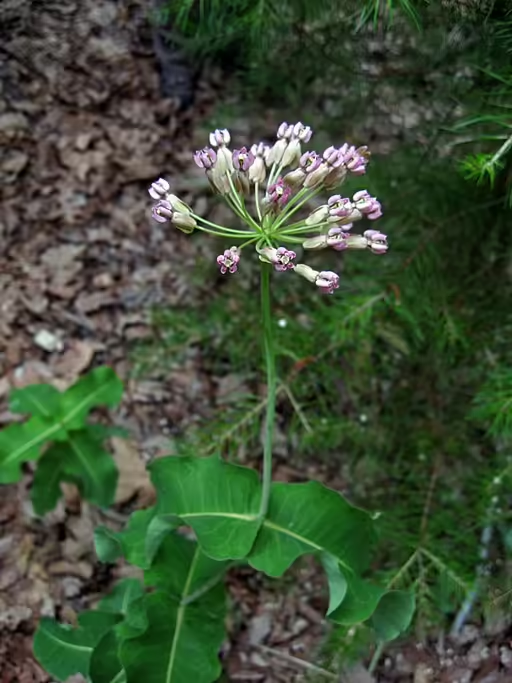
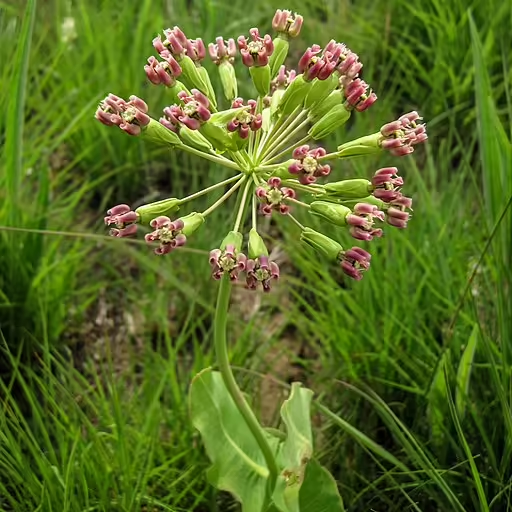

2. Western Sand Milkweed (Asclepias arenaria), a Milkweed for Sandy Soil
Western Sand Milkweed (Ascelpias arenaria): Western sand milkweed is native generally in the central and western parts of Kansas (Kartesz 2015). In the wild, Western sand milkweed grows in open places such as fields, pastures, dunes, sandhills, and roadsides. This milkweed grows up to 3 feet tall, and has pale-green to greenish-white flowers having a purplish hue that bloom from May to October.
In your Kansas butterfly garden, western sand milkweed requires sandy well-drained soil in full sun and is hardy in zones 4-9. Seeds of western sand milkweed can be purchased in the McMullen House Bed & Breakfast Garden Shop.
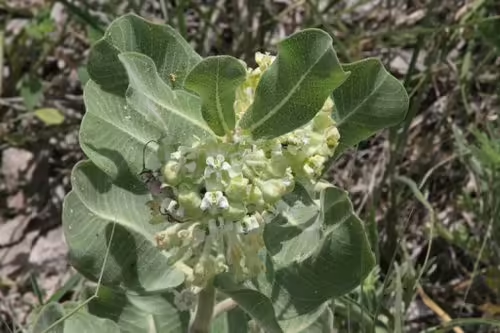

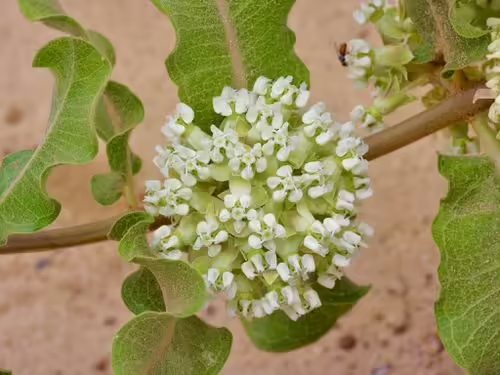
3. Spider Milkweed (Asclepias asperula), a Milkweed for Dry Soils
Spider Milkweed (Ascelpias asperula): Spider milkweed is native generally in the central parts of Kansas (Kartesz 2015). Spider milkweed has two subspecies, one of which, subspecies capricornu is in Kansas. In the wild, Spider milkweed is found in dry open habitats such as desert swales and scrub and pastures. Growing from 1 to 3 feet high, the cream-green flowers bloom from April to June and it is hardy in zones 5-9.
In your Kansas butterfly garden, spider milkweed requires a full sun exposure with dry and/or rocky soils. Seeds of spider milkweed can be purchased in the McMullen House Bed & Breakfast Garden Shop.
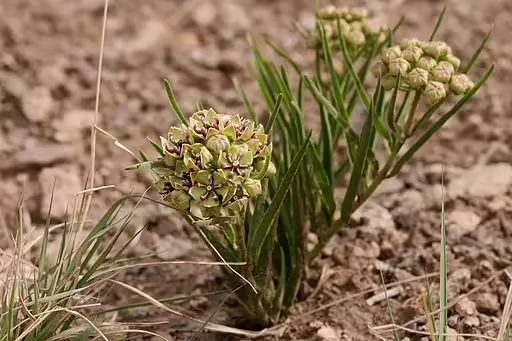
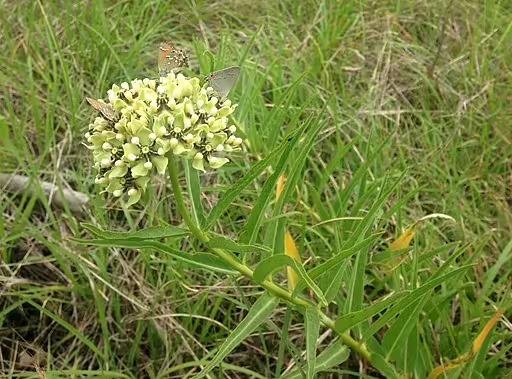

4. Engelmann’s Milkweed (Asclepias engelmanniana), a Milkweed for Dry Soils
Engelmann’s Milkweed (Ascelpias engelmanniana): Engelmann’s milkweed is native to the mainly to the western part of Kansas with a scattered distribution in the east (Kartesz 2015). In the wild, Engelmann’s milkweed is found in dry open habitats such as desert swales, scrub and pastures. Growing from 2 to 5 feet tall, this plant has cream-green flowers that bloom from May to September.
In your Kansas butterfly garden, Engelmann’s milkweed requires full sun, dry sandy or limestone soils and is hardy in zones 5-9. Seeds of Engelmann’s milkweed can be purchased in the McMullen House Bed & Breakfast Garden Shop.

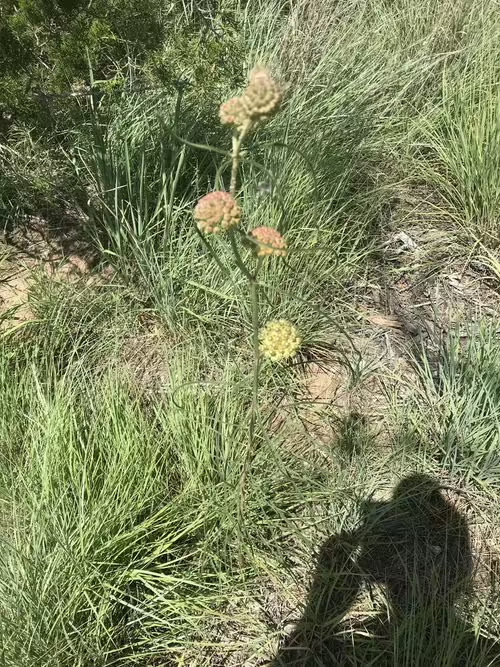

5. Swamp Milkweed (Asclepias incarnata), a Milkweed for Moist Soils
Swamp Milkweed (Asclepias incarnata): Swamp milkweed has two subspecies, ssp. incarnata and ssp. pulchra. The former is found throughout the state (hardy in zones 3-9), while the latter is not found in Kansas (Kartesz 2015). Like the name suggests in the wild it is found in wet places including the shores of streams, lakes, ponds, and other wetlands. This is one of the taller milkweeds growing from 3 to 5 feet tall. The flowers, which bloom from July to September are generally a pink to red color, but there is also a white cultivar (pictured below).
In your Kansas butterfly garden, swamp milkweed requires full sun to part shade and prefers moist to medium moisture soil, but it can exist in drier soil. Seeds of swamp milkweed can be purchased in the McMullen House Bed & Breakfast Garden Shop.
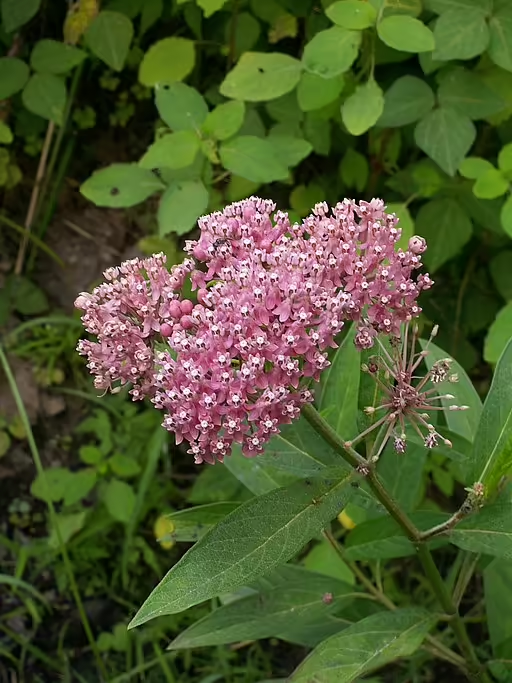

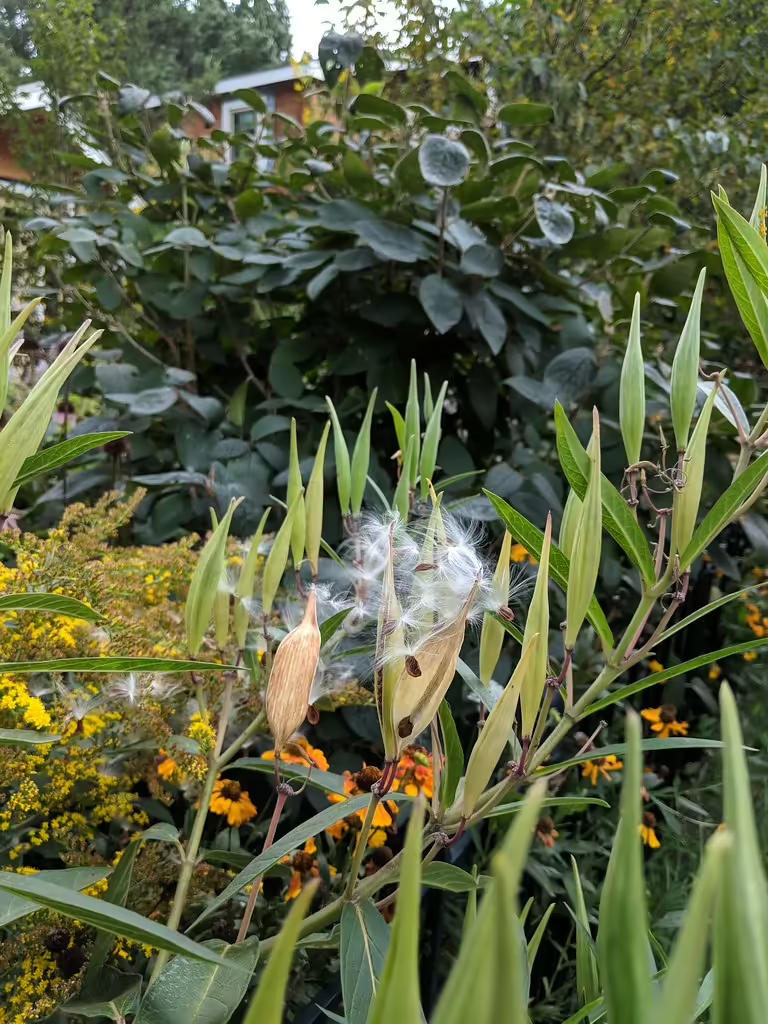
6. Side-Cluster Milkweed (Asclepias lanuginosa), a Rare Kansas Milkweed
Side-cluster Milkweed (Asclepias lanuginosa): Side-cluster milkweed is native and rare in scattered locations throughout the state (Kartesz 2015). In the wild, Side-cluster milkweed grows in prairies and sandhills having full sun. The height of this milkweed is variable and ranges from 0.5 to 4 feet tall, but can grow up to 6 feet in favorable places. The flowers range in color from green to cream and bloom from May to July.
In your Kansas butterfly garden, side-cluster milkweed is hardy in zone 4-7 and requires full sun and dry soil. However, it is rare and not in the horticultural trade.
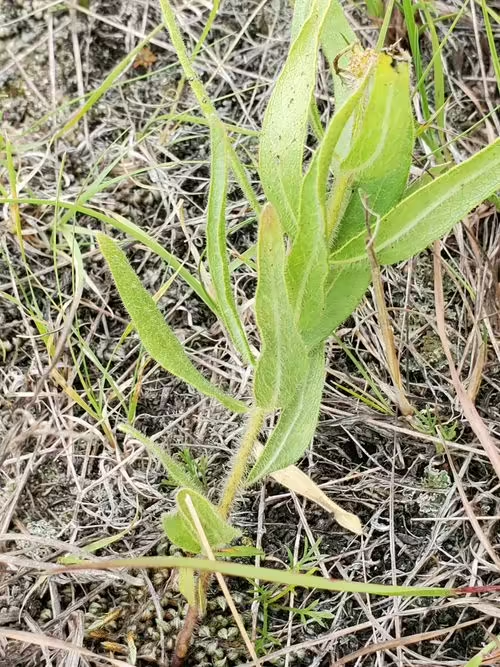

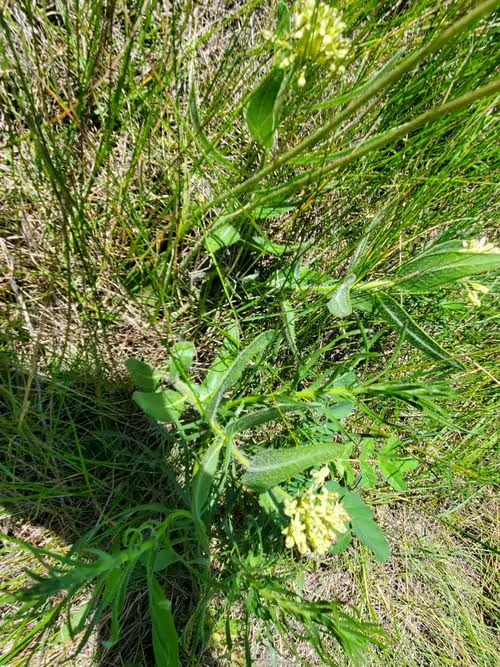
7. Broad-leaf Milkweed (Asclepias latifolia), a Milkweed for Dry Sandy Soils
Broad-leaf Milkweed (Asclepias latifolia): Broad-leaf milkweed is native to the central and western parts of Kansas (Kartesz 2015). In the wild, broad-leaf milkweed grows in open areas having full sun such as prairies, roadsides, and other right-of-ways. Growing from 1 to 3 feet tall, the greenish to yellow flowers bloom from May to August and it is hardy in zones 5-8.
In your Kansas butterfly garden, broad-leaf milkweed grows best in places having full sun to part-shade with dry sandy soils. Seeds of broad-leaf milkweed can be purchased in the McMullen House Bed & Breakfast Garden Shop.

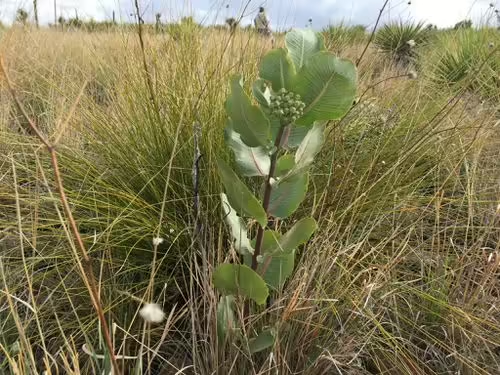

8. Long-leaf Milkweed (Asclepias longifolia), a Milkweed for Moist Soils
Long-leaf Milkweed (Asclepias longifolia): Long-leaf milkweed is native in the eastern part of Kansas and one county in the central part (Kartesz 2015). In the wild, long-leaf milkweed grows in moist areas and wetlands such as bogs, swamps, wet flatwoods, and moist prairies. Growing from 1 to 2.5 feet tall, the greenish-white flowers bloom from April to July.
In your Kansas butterfly garden, long-leaf milkweed requires full sun, moist to wet soils, and is hardy in zones 4-9.
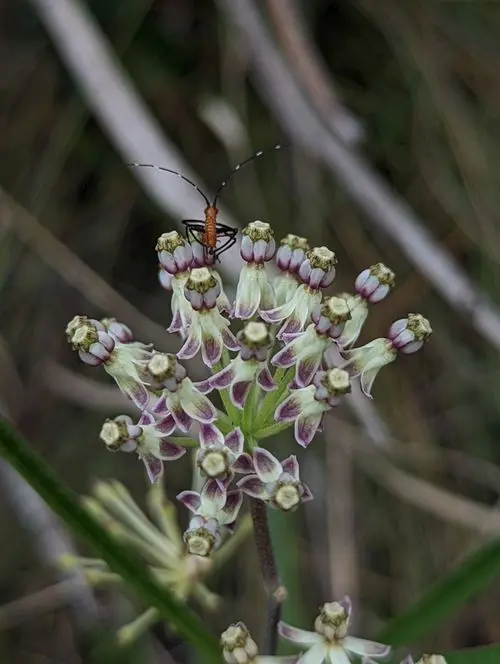


9. Mead’s Milkweed (Asclepias meadii), a Rare Kansas Milkweed
Mead’s Milkweed (Asclepias meadii): Mead’s milkweed is native and rare in the eastern part of Kansas (Kartesz 2015). In the wild, Mead’s milkweed grows in tallgrass prairies, hay meadows, and barrens having full sun. Growing from 1 to 3 feet tall, the greenish-white to yellow flowers bloom from June to July. This plant is federally endangered and is not in cultivation.
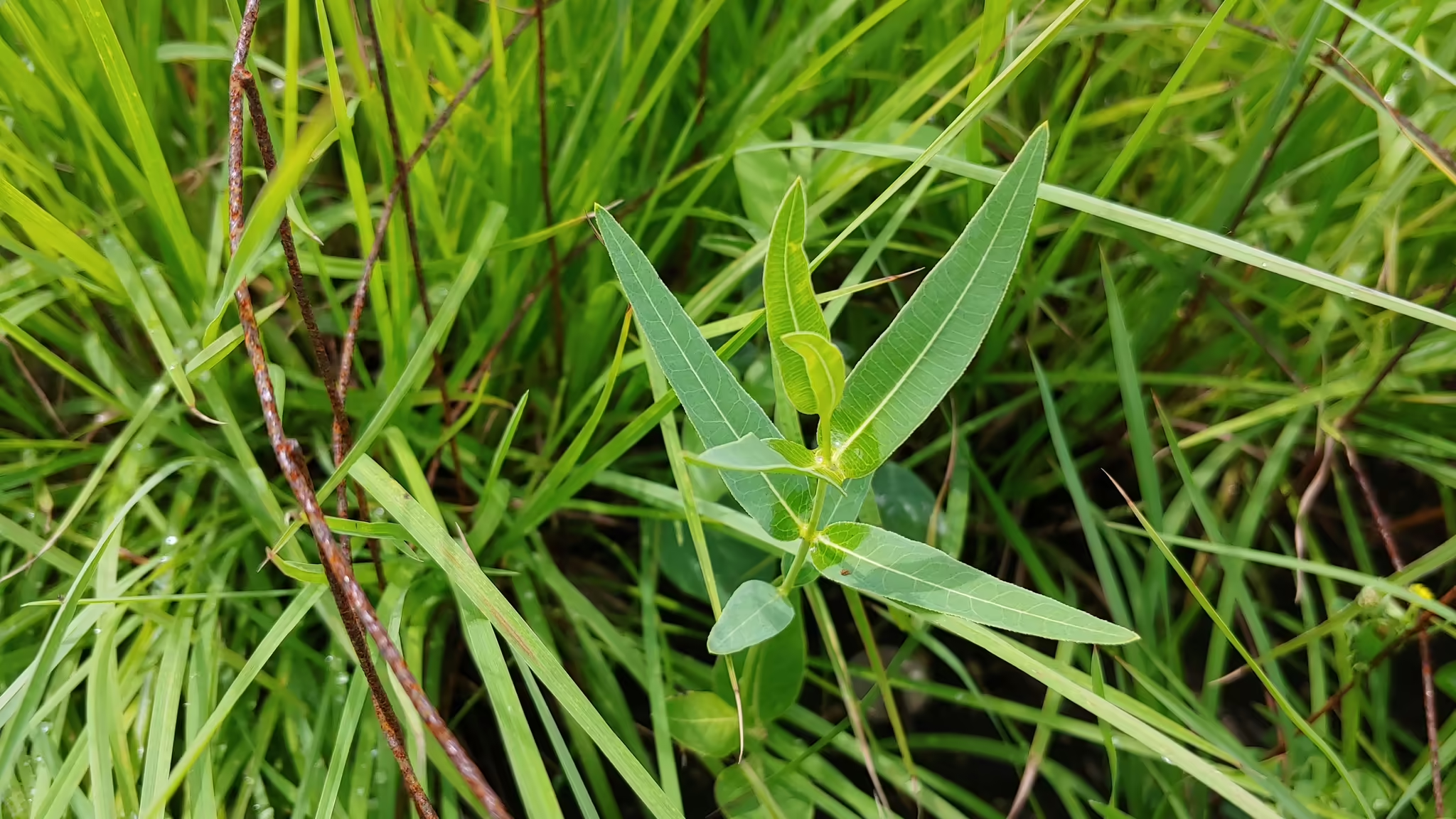
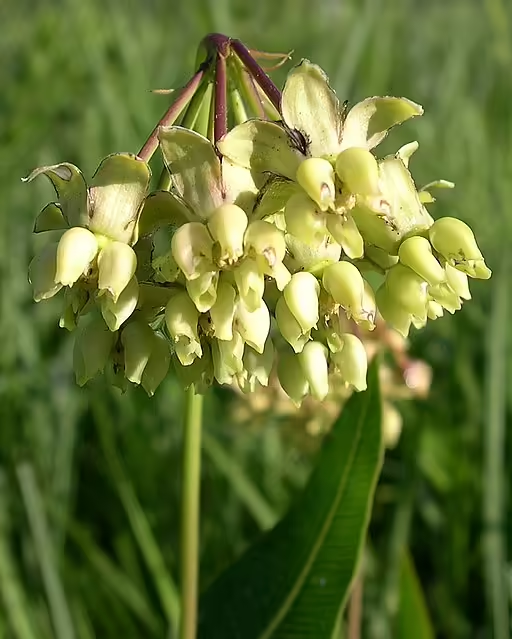
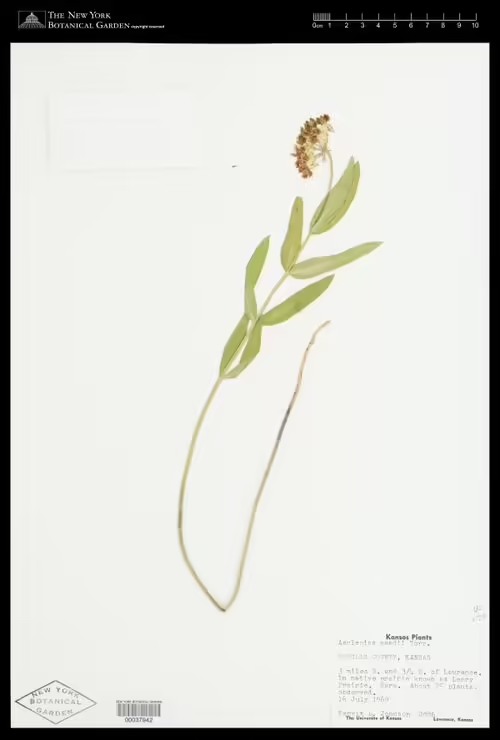
10. Low Milkweed (Asclepias pumila), a Milkweed for Dry Soils
Low Milkweed (Asclepias pumila): Low milkweed is native to the central and western parts of Kansas (Kartesz 2015). In the wild, Low milkweed grows in dry open areas having full sun such as prairies. One of the shorter milkweeds, this plant grows from 0.5 to 1.5 feet tall. The flowers are white, greenish-white or yellowish-white with hints of red and bloom from July to September.
In your Kansas butterfly garden, low milkweed requires full sun, dry sandy and/or gravelly soils, and is hardy in zones 5-9.

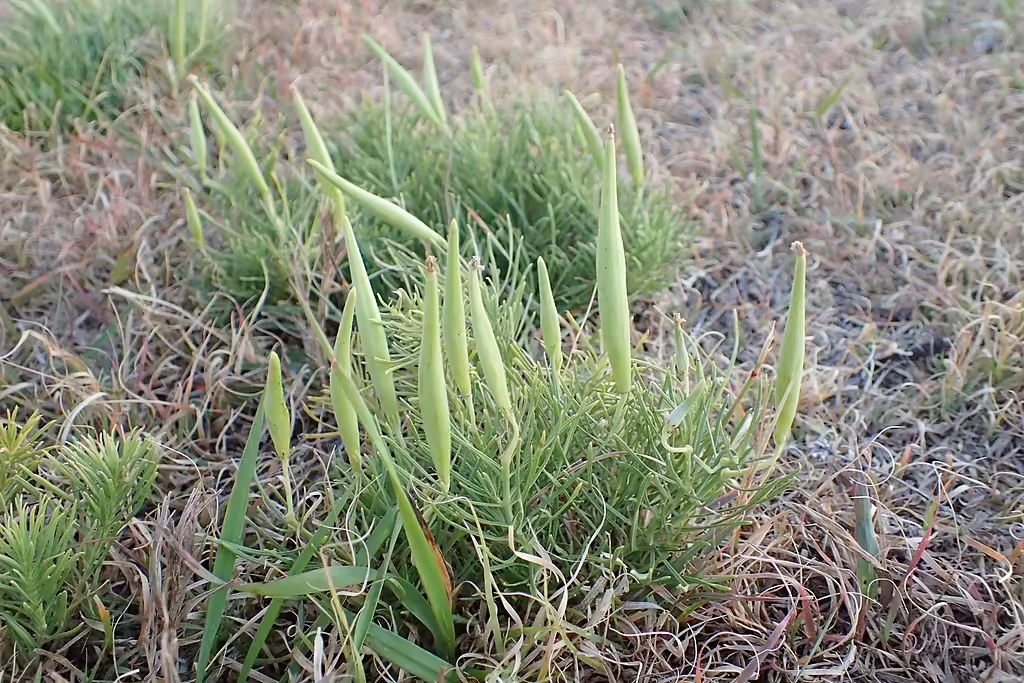

11. Purple Milkweed (Asclepias purpurascens), a Milkweed for Moist Soils
Purple Milkweed (Asclepias purpurascens): Purple milkweed is native in the eastern part of Kansas (Kartesz 2015). In the wild, purple milkweed grows in moist to dry places having full sun to part shade such as swamps, woodlands, meadows, roadsides, and dry fields. Growing up to 6 feet tall, this plant has purple to pink flowers that bloom from May to July.
In your Kansas butterfly garden, purple milkweed is hardy in zones 3-8 and requires part shade but can handle full sun. Soils should be moist and well-drained, but dry soil can be tolerated. Seeds of purple milkweed can be purchased in the McMullen House Bed & Breakfast Garden Shop.

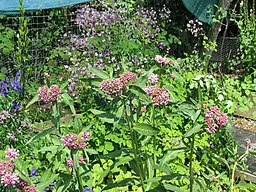

12. Four-leaf Milkweed (Asclepias quadrifolia), a Milkweed for Dry Rocky Soils
Four-leaf Milkweed (Asclepias quadrifolia): Four-leaf milkweed is native and rare to Cherokee County in the southeastern part of Kansas (Kartesz 2015). In the wild, four-leaf milkweed grows in open areas such as roadsides, pastures, and prairies. Growing from 1 to 3 feet tall, this plant has white to pink flowers that bloom from April to July.
In your Kansas butterfly garden, four-leaf milkweed is hardy in zones 5-8 and grows best in places of full sun to part-shade with dry rocky soils.
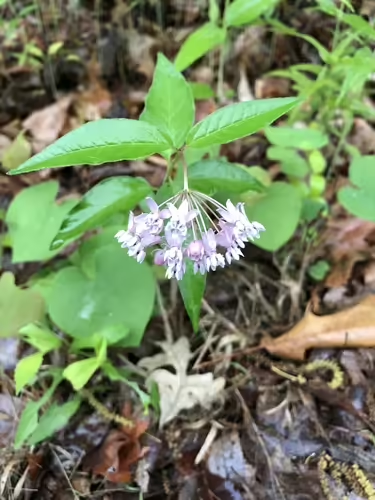


13. Showy Milkweed (Asclepias speciosa), a Milkweed for Medium to Dry Soils
Showy Milkweed (Asclepias speciosa): Showy milkweed is native in the central and western parts of Kansas (Kartesz 2015). In the wild, showy milkweed grows in mesic to dry open areas such as roadsides, fields, and woodlands. Growing from 1 to 3 feet tall, this plant has purple to pink flowers that bloom from April to June.
In your Kansas buttefly garden, showy milkweed is hardy in zones 3-9 and requires places of full sun having medium to dry well-drained soil. Seeds of showy milkweed can be purchased in the McMullen House Bed & Breakfast Garden Shop.



14. Slim-leaf Milkweed (Asclepias stenophylla), a Milkweed for Dry Soils
Slim-leaf Milkweed (Asclepias stenophylla): Slim-leaf milkweed is native throughout Kansas (Kartesz 2015). In the wild, slim-leaf milkweed grows in open areas with full sun such as prairies and sandy areas. Growing from 0.5 to 3 feet tall, this milkweed has greenish-white flowers that bloom from June to August.
In your Kansas butterfly garden, slim-leaf milkweed is hardy in zones 3-9 and requires full sun and dry sandy or gravelly soils. Seeds of slim-leaf milkweed can be purchased in the McMullen House Bed & Breakfast Garden Shop.


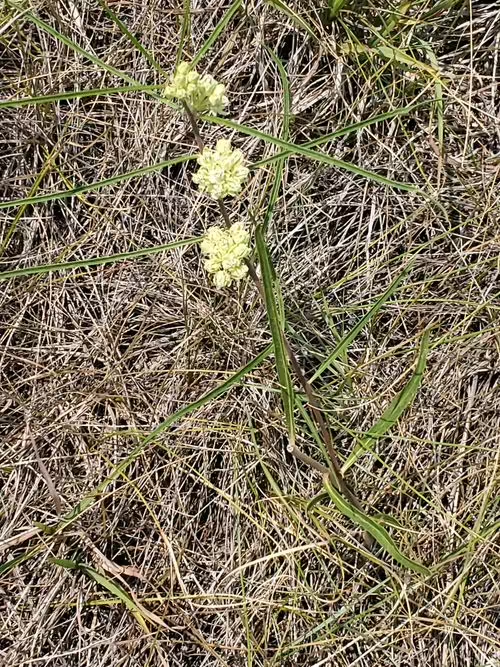
15. Horsetail Milkweed (Asclepias subverticillata), a Milkweed for All Soils
Horsetail Milkweed (Asclepias subverticillata): Horsetail milkweed is native in the western part of Kansas (Kartesz 2015). In the wild, horsetail milkweed grows in open areas with full sun such as rocky plains and flats, roadsides, waste places, and marshes and wet areas. Growing up to 4 feet tall, this milkweed has white to greenish-white flowers that bloom from May to September.
In your Kansas butterfly garden, horsetail milkweed is hardy in zones 5-8, requires full sun, and can handle a variety of moisture conditions. Seeds of horsetail milkweed can be purchased in the McMullen House Bed & Breakfast Garden Shop.
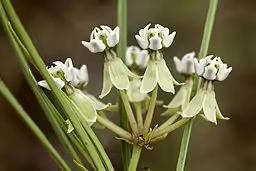
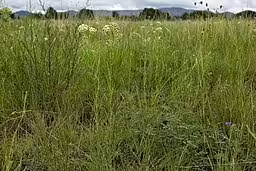

16. Sullivant’s Milkweed (Asclepias sullivantii), a Milkweed for Medium to Dry Soils
Sullivant’s Milkweed (Asclepias sullivantii): Sulivant’s milkweed is native to the central and eastern parts Kansas (Kartesz 2015). In the wild, Sullivant’s milkweed grows in open areas with full sun such as prairies, meadows, roadsides, and railroads. Growing from 2 to 5 feet tall, the pink to purplish flowers bloom from June to July.
In your Kansas buttefly garden, Sullivant’s milkweed is hardy in zones 3 to 7 and requires full sun with medium to dry sandy soil. Seeds of Sullivant’s milkweed can be purchased in the McMullen House Bed & Breakfast Garden Shop.



17. Common Milkweed (Asclepias syriaca), a Milkweed for All Soils
Common Milkweed (Asclepias syriaca): Common milkweed is native throughout Kansas, but is scattered in the west (Kartesz 2015). In the wild, common milkweed grows in open areas such as fields, pastures, and roadsides, where there is full sun. One of the taller milkweeds, it can grow up to 6 feet tall and has flowers ranging from pink, greenish-purple, greenish-white, to white that bloom from June to August.
In your Kansas butterfly garden, common milkweed is hardy in zones 3-9. Seeds of common milkweed can be purchased in the McMullen House Bed & Breakfast Garden Shop.
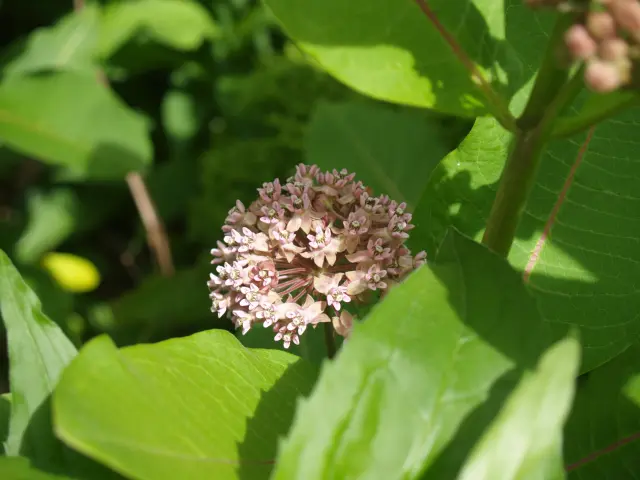

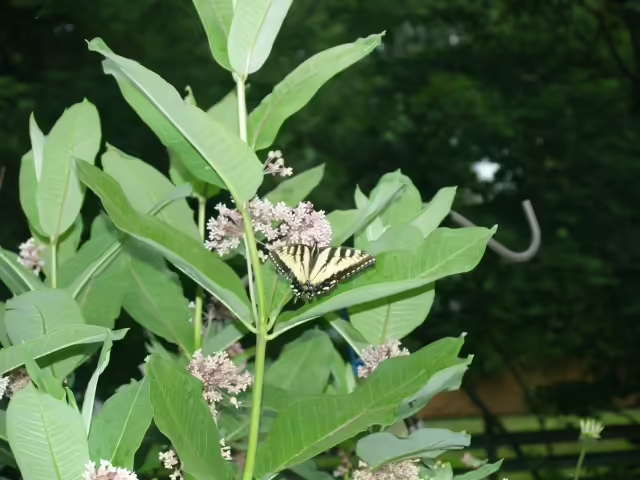
18. Butterfly Weed (Asclepias tuberosa), a Milkweed for All Soils
Butterfly Weed (Asclepias tuberosa): Butterfly weed is one of the most common for butterfly gardeners on the east coast of the United States. In Kansas, subspecies interior of this species occurs in the central and eastern parts of the state (Kartesz 2015). In the wild, It grows in open areas with full sun such as fields, roadsides, and open woods. Growing from 1 to 3 feet tall, it has characteristically orange flowers that bloom throughout the summer and sometimes into the autumn.
In your Kansas butterfly garden, butterfly weed is hardy from zones 3-9. Seeds of butterfly weed can be purchased in the McMullen House Bed & Breakfast Garden Shop.
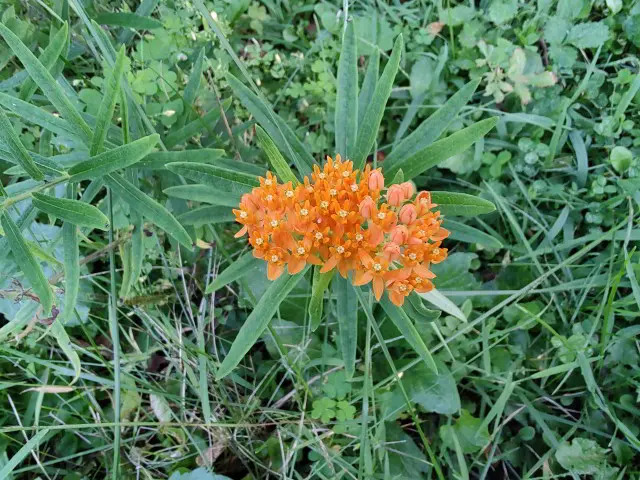
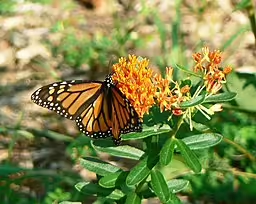

19. Whorled Milkweed (Asclepias verticillata), a Milkweed for Medium to Dry Soil
Whorled Milkweed (Asclepias verticillata): Whorled milkweed is native in the central and eastern parts of Kansas with a scattered distribution in the west (Kartesz 2015). Whorled milkweed has green to white flowers that bloom from May to September. In the wild, like a lot of other milkweeds, it grows in open areas such as meadows and fields, taking advantage of full sun.
In your Kansas butterfly garden, whorled milkweed is hardy in zones 3-9, requires full sun to part shade, and medium to dry soil. Seeds for whorled milkweed can be purchased at the McMullen House Bed & Breakfast Garden Shop.

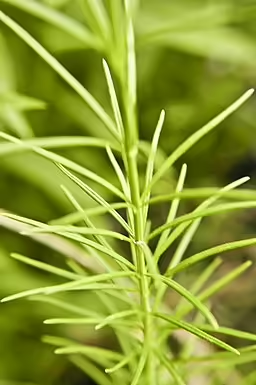

20. Green Comet Milkweed (Asclepias viridiflora), a Milkweed for Medium to Dry Sandy Soils
Green Comet Milkweed (Asclepias viridiflora): Green comet milkweed is native throughout Kansas (Kartesz 2015). In the wild, it grows in open areas such as meadows and fields having full sun. Growing up to 3 feet tall, it has flowers that start out green and age to become yellow and purple tinged that bloom from June to August.
In your Kansas butterfly garden, green comet milkweed is hardy in zones 3-9, requires full sun to part shade, and medium to dry sandy soil. Seeds of green comet milkweed can be purchased at the McMullen House Bed & Breakfast Garden Shop.
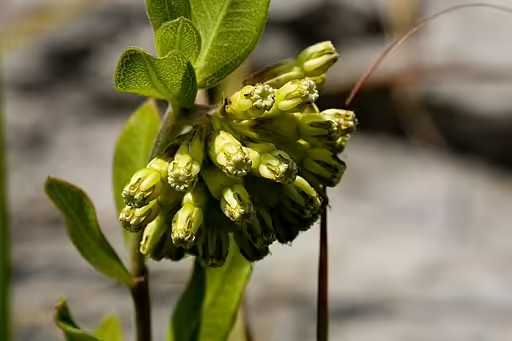


21. Green Milkweed (Asclepias viridis), a Milkweed for Medium to Dry High pH Soils
Green Milkweed (Asclepias viridis): Green milkweed is native to the central and eastern parts of Kansas and one county in the west (Kartesz 2015). In the wild, green milkweed grows in open areas such as glades, prairies, roadsides, and pastures where there is full sun. Growing from 0.5 to 2 feet tall, it has green, yellowish-green, or white flowers that bloom from April to October.
In your Kansas butterfly garden, green milkweed is hardy in zones 5-9 and requires medium to dry soils having a high pH. Seeds of green milkweed can be purchased at the McMullen House Bed & Breakfast Garden Shop.



When selecting your Kansas milkweed, be sure to make sure it grows in your zone and habitat.
References for Kansas Milkweeds
- Kartesz, J.T. The Biota of North America Program (BONAP). 2015. Taxonomic Data Center. Link to website. Chapel Hill, N.C. [maps generated from Kartesz, J.T. 2015. Floristic Synthesis of North America, Version 1.0. Biota of North America Program (BONAP). (in press)]